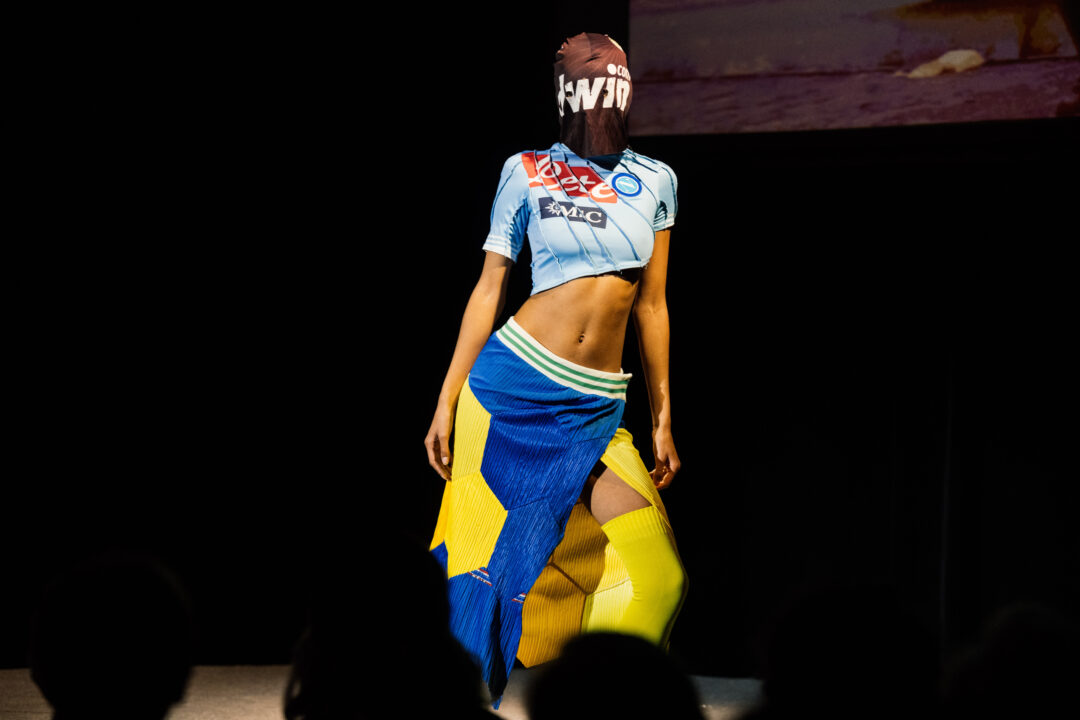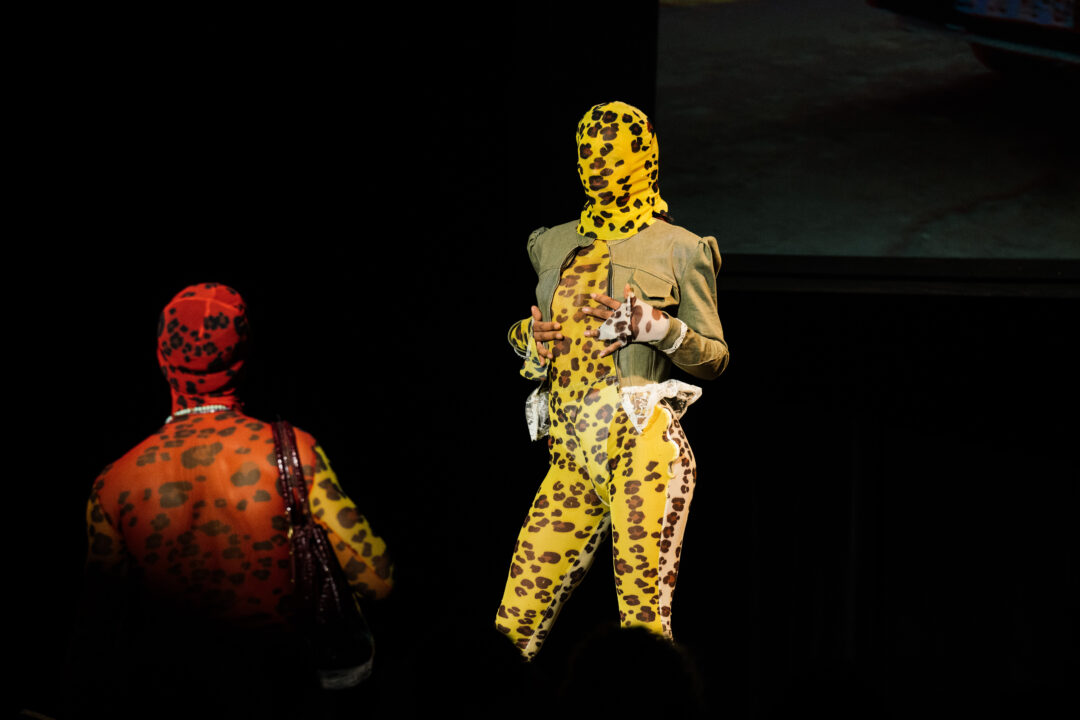Text by Quynh Tran
Photos by Camille Blake

Imagine a “pre-owned” or “pre-loved” garment in the Global North, where these terms have recently come to signify a savvy, responsible buyer, and a romanticized idea springs to mind of a treasure-hunter strolling through a quaint vintage market in a hip neighborhood. Flip the poles and consider that same garment in the context of the Global South, and it may have been scavenged out of necessity from the surplus waste offloaded on the markets of the poor.
The fault lines between what we’ve come to call the Global North and the Global South are deeply woven into the things we wear, many of which were produced in the sweatshops of the South for the consumerist temples of the North. In an ironic twist, a hyper-capitalist boomerang sends those very items back, and into a market of excess disposal. Some African countries have become both a smorgasbord of industrial resources for global industries and a landfill for the things Europe no longer desires. The influx of discarded textiles, for example, has reached a point where some countries now call for a ban on European second-hand imports.
Dunusa Market as a State of Mind
At Johannesburg’s most famous flea market, the Dunusa market, discarded clothes from Europe arrive in fifty-kilo bundles. They’re piled on the floor and sold by weight. In fact, the word Dunusa has taken on a new meaning, describing the act of bending down and pointing one’s backside outward as shoppers do when they sift through heaps of used garments. These fabrics have become a boon and a burden. The one-way flow of goods has created a trade ecosystem that has made clothing more affordable for the less affluent.
However, the industry is slowly killing local textile production. The hidden cost of the global market is the erosion of the very fabric of local craftsmanship. “This wouldn’t happen if it wasn’t waste for Europeans,” says Johannesburg-based designer Aidan Jayson Peters. Donating your unwanted clothes to organizations that send them to Africa is not as sustainable as some may think, he emphasizes, as most of the garments end up in massive landfills rather than being reused.
Nevertheless, this is where Peters sourced the fabrics for his debut collection Deadstock–Life of a Garment. The young designer eschewed the classic model of working with themes and mood boards, replacing them instead with the ingenuity of the street. He pays homage to Dunusa as a state of mind. “It’s less about the ideas than what’s out there and what we can make of it,” he says. A cornucopia of discards, Dunusa market provided him with a bundle of used denim, old sportswear, leather, worn-out stretch shirts, and office wear. Peters embarked on a trajectory of trial and error to explore the interdependences of the global fashion market. This resulted in a sixteen-piece avant-garde collection, interwoven with the threads of critical dialogue on the disproportionality of resource consumption between the North and the South.


A Gesture of Liberation
Peters explores the boundaries of concept-driven design through the deconstruction and upcycling of discarded clothing. The collection picks up on the black, red, and white color palette of the ubiquitous polyester tartar bag that originated in Hong Kong yet has traveled so widely it now has as many names as destinations. A soccer-fan jersey is carefully cut into diamond-shaped patterns and turned into a sculptural, custom-made quilted vest. Denims are twisted into draped skirts and a trench coat gets a Dunusa makeover with checked patchwork. The bold shapes of inflated white-collar silhouettes feature scraps of streetwear highlighted by intricate Zulu crochet pieces. The act of making “crazy, beautiful clothes” from discarded garments and integrating the craftsmanship of local artisans becomes a gesture of liberation in a cycle dominated by European markets.
A Nascent Cultural Identity
Growing up in the small town of Kimberley, famed for its diamond mine, Peters describes a sheltered childhood. His environment was influenced by football and cars rather than the arts, but his parents encouraged his creative forays into fashion and film. At the age of sixteen, he founded the streetwear label LO-C-DORE with a friend, citing Virgil Abloh’s Pyrex Vision and the aesthetics of the early 2010s as an influence. Peters would have been labeled “Colored” under the Apartheid regime, and he considers his cultural identity in post-Apartheid South Africa to be a nascent one. “We’ve only existed for a few decades. We are still creating this culture and shaping this identity and I’m part of it,” he says.
After a short stint studying law in Cape Town, he went on to study fashion design at South Africa’s Stadio School of Fashion. But it was Forecast’s mentorship program with Irakli Rusadze that took him out of South Africa for the first time. “I’m only slowly being introduced to the world,” Peters says. He creates his collection under the moniker Klein Muis, a nickname that stuck from childhood and translates as “little mouse.” Having gone on a work-stay to Mexico City as part of the mentorship program, Peters elaborates on how these experiences find their way into his work: “Johannesburg is a space that is meant to serve a purpose, but in Mexico City, I found architects like Luis Barragán and Tatiana Bilbao putting thought into how edifices can be humanized.” He considers the complex history of Johannesburg and South Africa critical to his work and identity, but it is the approach of humanization through design that Peters explores through Klein Muis.
Indeed, his debut collection reflects the complex topologies of South Africa, and that’s one of the reasons why it is also accompanied by a film and an editorial. To him, fashion is art, but intimate conversations with his mentor Rusadze have nurtured both a sense of practicality and responsible production. As much as his debut offers a humanist perspective on the sweatshop machinations of a faceless fashion industry, Peters is also discussing the possibilities of responsible economic development. “I’m trying to get out of the cycle of seasons for the sake of an alternative schedule based on when I have something to say,” he explains. “I’m at the very beginning of the journey.” And he is taking time to find where he wants to go, on his own terms.
You are currently viewing a placeholder content from Vimeo. To access the actual content, click the button below. Please note that doing so will share data with third-party providers.
More Information